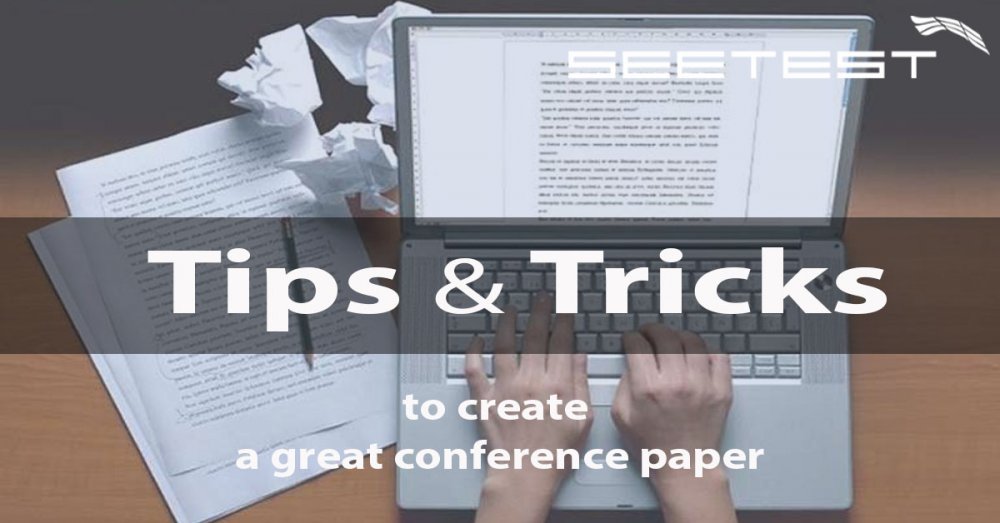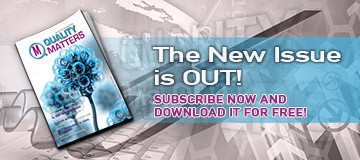12 tips and tricks to create a great conference paper
- 30 Mar 2018

Participation at an international conference can be a great way to introduce your work to colleagues, get the attention of your boss and boost your career. This is the star moment when you can contribute to the community and generate an interest in your sphere. But before you get approved to take part in such event, there is a long way to go.
SEETEST conference opens a public Call for papers every year which provides an opportunity for both junior and senior specialists in Quality Assurance to submit papers and become speakers. “How to create a great conference paper?” is the question which brought together conference organizers, the Best paper winners, and Program Committee members, in order to provide you some useful tips.
1. Read all the requirements and don’t be afraid to ask if you have any questions. Ensure that you have read all available information about the requirements, expectations, topics and paper templates. Clarify what the benefits of participating are for you and what your contribution to the conference would be. If there is anything that is not clear to you, don’t be afraid to ask.
2. The title is important. It is the first thing that reviewers will read so it should be reflective of the content, smart and memorable. Ask yourself and your colleagues “Does it make them want to read on?”.
3. Choose a topic you are comfortable with. It should be something that you have intensively worked on or something that you have extensively studied. By doing this you will be able to show that you can master the theme in details that actually catch the audience’s attention. This is what the Best Paper winner at SEETEST 2017 Cristiana Maria Gusanu has shared that works best for her.
4. Invest time in creating an engaging abstract. It is hard work and takes much time to start to type so invest there first. How you write about the topic in your abstract will influence how interesting it seems. It should be engaging, insightful and easy to read. Make an impact and you have a chance to win!
5. Submit a full paper, not only the title and abstract. Submitting a full paper allows the reviewers to get a better view of your expertise. They will be able to understand the originality and the value of your work. SEETEST conference chair Mitko Mitev who is experienced in reviewing papers and speaking at conferences, comments that popular testing conferences receive a lot of submissions which makes the acceptance more difficult. That’s why the Program Committee members tend to vote and select papers which they have read in details.
6. You have to have a thesis. Which means only ONE thesis! There is no point in writing a paper when you do not have a proposition. Similarly there is no point to write one paper when you have too many things to say. It's like modelling clay: If you mix too many colors it will turn up a disgusting purple-grey and no one would understand what your message was in the first place. Just keep it simple and focus on one topic with clear examples.
7. First make your readers want to read you and then write what you have to write. The best way to start an action movie is with a huge blast. When you have everyone's attention, just make sure that you meet their already high expectations. In this area anything goes! Be intuitive, be inspiring, be uplifting, be radical, be controversial, be hilarious, and be contradictious but never, ever start flat. Being flat is a good strategy only for insomnia.
8. Bring in your own bit, your own contribution. Even if you are writing about a well-known subject, that doesn’t mean that you cannot have your own contribution to it. That can be a unique way that you have applied something into your everyday tasks, or an example of how some theoretical principle can be extended to your work, or, why not, your own interpretation of some theoretical aspects.
9. Don't do it by yourself. It takes hard work to transform a vague idea into a great paper. Predrag Skokovic, experienced as a speaker, Best Paper winner and Program committee member, advises to engage your friends and colleagues to support you on this journey. Ask them to review your work and get feedback too.
10. Do NOT write a conference paper! Just tell a story instead. The best way to create takeaways to remember is to provide them through hard hitting, brain-catching stories. Use parables from something far more tangible than software. That way you make your message clear also to the ones that are not necessarily experts in the field. Avoid detailed technicalities, and, for God's sake, do not write code when you should be writing in human grammar, advises Sakis Ladopoulos awarded with Best Paper at SEETEST 2016.
11. Focus on creating an authentic and original content. Being original, even innovative is not an easy thing. This is what makes the difference between a successful paper and a boring one. Originality doesn’t come from walking on the stage barefoot or exploding into the microphone thinking that this will keep the audience awake. Neither does trying to be funny in a non-funny, rather ridiculous way. Originality comes from combining knowledge with novelty and agreeable stage presence and finding that fine line that separates and unites them at the same time.
12. Don’t wait until the last minute to meet the deadlines! Don't do a late rush submission. Have you ever submitted a paper and then a great idea comes to your mind? SEETEST submission system allows updating the submitted papers until the Call for Papers closes.
Creating a good paper takes a lot of time but, if it’s approved, speaking and sharing your ideas on stage will be a great experience. You’ll never know until you try, so go ahead and get started. You can read all about SEETEST 2018 Call for Papers and submit your paper here. Good luck!
SEETEST conference opens a public Call for papers every year which provides an opportunity for both junior and senior specialists in Quality Assurance to submit papers and become speakers. “How to create a great conference paper?” is the question which brought together conference organizers, the Best paper winners, and Program Committee members, in order to provide you some useful tips.
1. Read all the requirements and don’t be afraid to ask if you have any questions. Ensure that you have read all available information about the requirements, expectations, topics and paper templates. Clarify what the benefits of participating are for you and what your contribution to the conference would be. If there is anything that is not clear to you, don’t be afraid to ask.
2. The title is important. It is the first thing that reviewers will read so it should be reflective of the content, smart and memorable. Ask yourself and your colleagues “Does it make them want to read on?”.
3. Choose a topic you are comfortable with. It should be something that you have intensively worked on or something that you have extensively studied. By doing this you will be able to show that you can master the theme in details that actually catch the audience’s attention. This is what the Best Paper winner at SEETEST 2017 Cristiana Maria Gusanu has shared that works best for her.
4. Invest time in creating an engaging abstract. It is hard work and takes much time to start to type so invest there first. How you write about the topic in your abstract will influence how interesting it seems. It should be engaging, insightful and easy to read. Make an impact and you have a chance to win!
5. Submit a full paper, not only the title and abstract. Submitting a full paper allows the reviewers to get a better view of your expertise. They will be able to understand the originality and the value of your work. SEETEST conference chair Mitko Mitev who is experienced in reviewing papers and speaking at conferences, comments that popular testing conferences receive a lot of submissions which makes the acceptance more difficult. That’s why the Program Committee members tend to vote and select papers which they have read in details.
6. You have to have a thesis. Which means only ONE thesis! There is no point in writing a paper when you do not have a proposition. Similarly there is no point to write one paper when you have too many things to say. It's like modelling clay: If you mix too many colors it will turn up a disgusting purple-grey and no one would understand what your message was in the first place. Just keep it simple and focus on one topic with clear examples.
7. First make your readers want to read you and then write what you have to write. The best way to start an action movie is with a huge blast. When you have everyone's attention, just make sure that you meet their already high expectations. In this area anything goes! Be intuitive, be inspiring, be uplifting, be radical, be controversial, be hilarious, and be contradictious but never, ever start flat. Being flat is a good strategy only for insomnia.
8. Bring in your own bit, your own contribution. Even if you are writing about a well-known subject, that doesn’t mean that you cannot have your own contribution to it. That can be a unique way that you have applied something into your everyday tasks, or an example of how some theoretical principle can be extended to your work, or, why not, your own interpretation of some theoretical aspects.
9. Don't do it by yourself. It takes hard work to transform a vague idea into a great paper. Predrag Skokovic, experienced as a speaker, Best Paper winner and Program committee member, advises to engage your friends and colleagues to support you on this journey. Ask them to review your work and get feedback too.
10. Do NOT write a conference paper! Just tell a story instead. The best way to create takeaways to remember is to provide them through hard hitting, brain-catching stories. Use parables from something far more tangible than software. That way you make your message clear also to the ones that are not necessarily experts in the field. Avoid detailed technicalities, and, for God's sake, do not write code when you should be writing in human grammar, advises Sakis Ladopoulos awarded with Best Paper at SEETEST 2016.
11. Focus on creating an authentic and original content. Being original, even innovative is not an easy thing. This is what makes the difference between a successful paper and a boring one. Originality doesn’t come from walking on the stage barefoot or exploding into the microphone thinking that this will keep the audience awake. Neither does trying to be funny in a non-funny, rather ridiculous way. Originality comes from combining knowledge with novelty and agreeable stage presence and finding that fine line that separates and unites them at the same time.
12. Don’t wait until the last minute to meet the deadlines! Don't do a late rush submission. Have you ever submitted a paper and then a great idea comes to your mind? SEETEST submission system allows updating the submitted papers until the Call for Papers closes.
Creating a good paper takes a lot of time but, if it’s approved, speaking and sharing your ideas on stage will be a great experience. You’ll never know until you try, so go ahead and get started. You can read all about SEETEST 2018 Call for Papers and submit your paper here. Good luck!
Back to Articles



